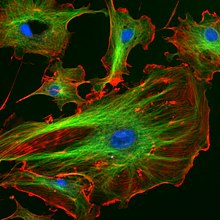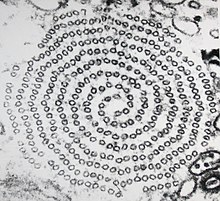Microtubule
| Parent |
| Cytoskeleton |
| Gene Ontology |
|---|
| QuickGO |
Microtubules are tubular protein complexes that, together with the microfilaments and the intermediate filaments, form the cytoskeleton of eukaryotic cells. They are jointly responsible on the one hand for the mechanical stabilization of the cell and its shape, on the other hand in interaction with other proteins for movements and transport within the cell as well as for active movements of the entire cell.
construction
Microtubules are aligned structures whose ends are labeled plus and minus because of their direction of polymerization. They consist of units, which in turn are composed as heterodimers without a covalent bond from one molecule each of α- (negative) and β- tubulin (positive). The units form sub-filaments (so-called protofilaments) through longitudinal connection, of which usually 13 laterally connect the wall of the microtubules. In the cell, microtubules are typically bound with their minus end (via the α-tubulin) to a microtubule organization center (MTOC ) which contains γ-tubulin. The tubulins of different organisms are not identical. As a result, the diameter of the microtubules vary between 20 and 30 nanometers .
Microtubules are relatively transient structures with an average lifespan in the order of 10 minutes, unless they are stabilized by incorporation into larger structures. In the cytoplasm of the cells there is usually an equilibrium between polymerized and depolymerized tubulin. The tubulin units are constantly grown on both the plus and minus ends of the microtubule and also depolymerized again, so that an equilibrium is created, with both processes running faster at the plus end. The end of the tube grows continuously and suddenly disintegrates over a longer distance (see dynamic instability ). If the equilibrium changes, the microtubules can completely dissolve. The opposite, exhaustion of the supply of tubulin units, is also possible. Low temperature and an excess of calcium ions promote the depolymerization of the microtubules. The dynamic network of microtubule filaments in the cell originates at the microtubule organizing center ( MTOC ). The build-up and breakdown of microtubules can be inhibited by cytoskeleton inhibitors .
organization

Numerous proteins are associated with microtubules, so-called MAPs ( microtubule associated proteins ). The best known are motor proteins like dynein and kinesin . Some MAPs appear to be able to stabilize microtubules. MAPs can connect microtubules to form larger structures. In particular, the axonemes , axial filaments of mobile cell appendages, should be mentioned here : the motile cilia and the eukaryotic flagella (flagella). An axoneme is a bundle in which nine double tubules surround two single ones in the center; one speaks of a (9 × 2 + 2) structure (see figure). The double tubules have an asymmetrical cross-section in which a complete “A-tube” merges with an incomplete “B-tube”.
Centrioles form another organizational unit ; these are tubes according to the (9 × 3 + 0) pattern. Individually, they function as the basal bodies of cilia and flagella. In animal cells, a pair of centrioles connected at right angles with a surrounding matrix containing γ-tubulin form the central body, centrosome , MTOC, which is usually found near the center of the cell and from which a few hundred microtubules grow in a star shape in all directions. If they reach the cortical layer of the cell, the so-called cell cortex, they can help to stabilize the shape of the cell by making contact with other elements of the cytoskeleton. The centrosome is doubled before the cells divide, and the two centrosomes now form the poles of the spindle apparatus , which in turn consists of microtubules and whose job it is to distribute the chromosomes to the daughter cells.
function
Apart from the constant build-up and breakdown at the ends, microtubules are rigid and immutable. However, they do not only have support functions in the cell. Motor proteins that hang along the microtubules (like caterpillars), consuming ATP , carry vesicles and granules through the cell. Kinesins usually transport towards the plus end, Dyneins towards the minus end. Before cell division , microtubules form the spindle apparatus , via which the chromatids are drawn to the poles of the cell (minus ends of the microtubules). In nerve cells, vesicles filled with neurotransmitters migrate from the cell body to the synapses in the plus direction, see axonal transport .
Cilia and flagella produce a different kind of movement . The axonemes described above contain dynein , among other things . By tensioning the microtubules against one another, the dynein bends the axoneme (ATP is also used for this). Cilia can generate currents by coordinating their phase and direction, see ciliates , or they can transport material in a lumen, see ciliated epithelium . Flagella move individual cells (e.g. sperm ) by beating back and forth. The (9 × 2 + 2) blueprint of the axoneme has been retained by evolution from primitive unicellular organisms to humans. The (9 × 2 + 0) blueprint also occurs frequently. Cilia of this type are mostly immobile. They form specialized cell compartments - e.g. B. the outer segment of ciliary photoreceptor cells , the chemoreceptors of the olfactory cells or flow detectors in liquids.
Importance in the fight against cancer

The microtubules are of great importance in the fight against cancer . Substances that disturb the dynamic balance of the assembly and dismantling of the microtubules, in particular, hinder the correct development and function of the spindle apparatus and thus act as mitotic toxins , i.e. that is, they prevent correct cell division and thus the growth of tumors and metastases. Some are used as cytostatics in chemotherapy . Alkaloids from the pink catharanth ( Catharanthus roseus , formerly Vinca roseus ), the vincristine and the vinblastine , precipitate tubulin. Paclitaxel (Taxol), an alkaloid from the Pacific yew tree ( Taxus brevifolia ), and the epothilone from the myxobacterium Sorangium cellulosum stabilize microtubules and prevent them from depolymerizing.
However, the cytostatics also work in other tissues or organs in which cells divide. These are z. B. epidermis, hair follicles, the bone marrow as the formation of immune and blood cells, the liver and the gonads. Accordingly, cytostatics have many significant side effects such as hair loss, intestinal bleeding or increased susceptibility to infection .
Importance for plant breeding
Colchicine , an alkaloid from the autumn crocus ( Colchicum autumnale ), inhibits the polymerization of the microtubules by binding the tubulin units and removing them from the circulation. By deliberately preventing meiosis , it could be used successfully to grow polyploid plants. In animal organisms, colchicine is considered to be germ-damaging.
Quantum Physics and Consciousness
Stuart Hameroff and Roger Penrose jointly hypothesized that consciousness- forming brain functions are based on macroscopic quantum effects that take place in the microtubules of the cell skeleton . At higher stages of evolution it is the microtubules of the brain neurons , but in principle this almost panpsychic mechanism even applies to single-cell organisms with a cytoskeleton .
Web links
literature
- Klaus Werner Wolf, Konrad Joachim Böhm: Organization of microtubules in the cell . In: Biology in Our Time. 27, 2, 1997, ISSN 0045-205X , pp. 87-95.
- James R Davenport, Bradley K Yoder: An incredible decade for the primary cilium: a look at a once-forgotten organelle. In: Am J Physiol Renal Physiol. 289, No. 6, 2005, pp. F1159-1169. doi : 10.1152 / ajprenal.00118.2005 . PMID 16275743 .
References, notes
- ^ S. Hameroff: How quantum brain biology can rescue conscious free will. In: Frontiers in integrative neuroscience. Volume 6, 2012, p. 93, doi : 10.3389 / fnint.2012.00093 , PMID 23091452 , PMC 3470100 (free full text).
- ^ S. Hameroff, R. Penrose: Consciousness in the universe: a review of the 'Orch OR' theory. In: Physics of life reviews. Volume 11, number 1, March 2014, pp. 39-78, doi : 10.1016 / j.plrev.2013.08.002 , PMID 24070914 (review).


